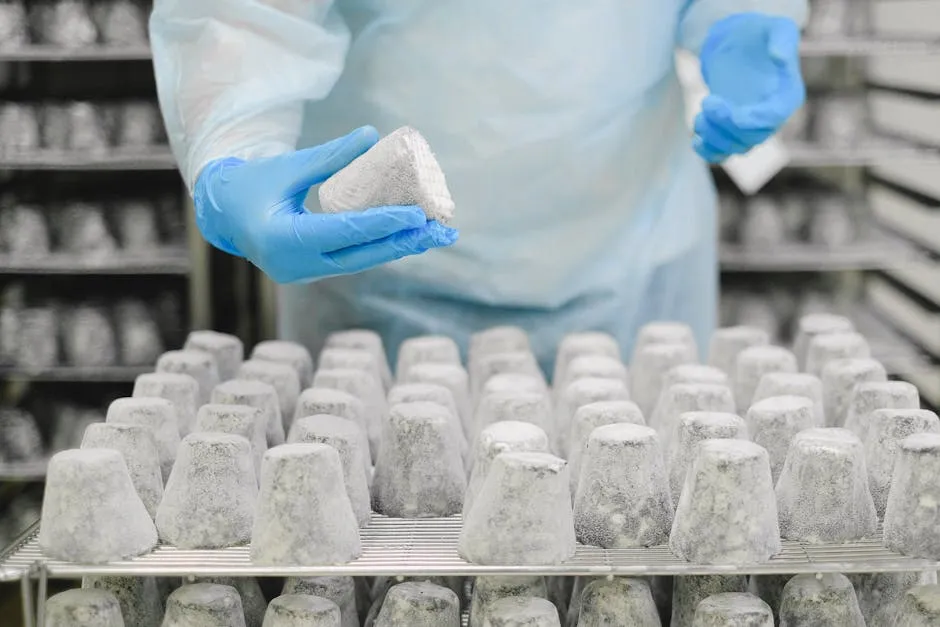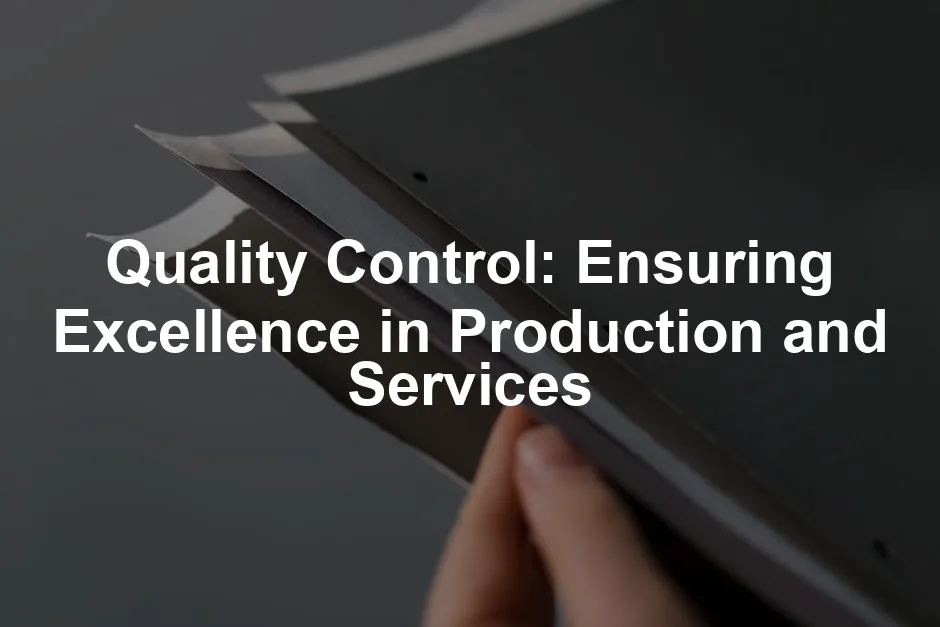Introduction
Quality control (QC) is a critical process that ensures products and services meet established standards. By maintaining high-quality benchmarks, businesses can enhance customer satisfaction and minimize defects. This article explores the essential aspects of quality control, its methodologies, and its significance across various industries.
Summary and Overview
Quality control is more than just inspecting products. It involves a comprehensive approach to ensuring quality at every stage of production. Essentially, QC identifies and rectifies issues before they affect the final product. Historically, QC has evolved from simple inspections to rigorous methodologies and standards.
The relationship between quality control and quality assurance (QA) is crucial. While QC focuses on detecting defects, QA emphasizes preventing them. Both are integral to a successful quality management system. In today’s industries, QC impacts customer satisfaction and business reputation significantly.
Several methodologies are employed in QC, including statistical process control and continuous improvement techniques. These methods help companies not only maintain standards but also reduce costs and enhance efficiency. Understanding these concepts is vital for anyone involved in production or service delivery.

For a deeper dive into the world of quality control, grab your own copy of the Quality Control Handbook by Joseph M. Juran. This book is a must-read for anyone wanting to master the art of quality control!
For a deeper understanding of the methodologies in quality control, consider exploring statistical process control anomaly reddit.
Quality Control vs. Quality Assurance
Quality control (QC) and quality assurance (QA) are often confused. However, they serve different purposes in maintaining product quality. QC focuses on identifying defects in finished products. It’s about ensuring that the end results meet specified standards. For example, a manufacturer might conduct inspections on the assembly line to catch defects.
On the other hand, QA emphasizes processes and systems designed to prevent defects. It’s proactive, aiming to improve production methods and reduce errors before they happen. Think of QA like a coach preparing a team for a game, while QC is like the referee checking for faults during the match.
Integrating both QC and QA is vital for effective quality management. When used together, they create a robust framework that enhances product quality. This ensures products not only meet standards but also satisfy customer expectations, driving business success.
Key Components of Quality Control
Inspection and Testing
Inspection and testing are core components of quality control. Various methods exist to ensure products meet required standards. Visual inspections are common; inspectors manually check products for defects. This can include looking for scratches or color inconsistencies.
Mechanical inspections involve using equipment to assess product functionality. These tests might include weight measurements or pressure tests to confirm safety. Testing at different production stages is crucial. It allows for early detection of issues, saving time and resources.
Inspectors play a vital role in the quality control process. They utilize specialized testing equipment to gather data and make informed decisions. Their attention to detail ensures that only quality products reach consumers, enhancing overall satisfaction.

Speaking of testing equipment, consider investing in a Digital Caliper. This handy tool will help you achieve precise measurements and ensure quality in your projects!
Statistical Process Control (SPC)
Statistical Process Control (SPC) is a powerful tool in quality control. It uses statistical methods to monitor and control production processes. The primary goal is to ensure that processes operate at their full potential.
SPC involves tools like control charts, which visually represent process performance over time. These charts help identify variations that might indicate problems. By analyzing this data, businesses can make informed adjustments to maintain quality.
The benefits of using SPC are significant. It helps reduce waste, enhance efficiency, and improve product consistency. By focusing on data-driven decisions, companies can achieve higher quality standards, ultimately boosting customer trust and satisfaction.

To learn more about the definition and importance of SPC, visit spc statistical process control definition.
Documentation and Record-Keeping
Thorough documentation is vital in quality control. It ensures that all QC processes are well-documented and easily traceable. This includes various types of records such as inspection reports, test results, and corrective action plans. Each document serves as a crucial piece of the puzzle in maintaining product quality.
Moreover, keeping detailed records aids in audit trails and compliance. When regulatory bodies review your processes, clear documentation helps demonstrate adherence to industry standards. It also provides transparency, which is essential for building trust with clients and stakeholders.
Data analysis plays a significant role in continuous improvement. By regularly reviewing documented information, businesses can identify trends and areas needing enhancement. This proactive approach helps prevent issues before they arise, contributing to higher overall quality. In essence, effective record-keeping not only supports compliance but also fuels innovation in QC processes.

If you’re looking to enhance your documentation process, you might want to check out The Quality Toolbox. It provides valuable tools and techniques to streamline your quality management system!
Quality Control Methods
Common QC Techniques
Quality control methods vary widely, each offering unique benefits and drawbacks. One of the most popular techniques is Acceptance Sampling. This method involves testing a random sample of products from a batch to determine if the entire batch meets quality standards. While it’s cost-effective, it may miss defects in untested items.
Another prevalent method is 100% Inspection. Here, every single product is examined before reaching the customer. This technique guarantees that only flawless items are delivered, but it can be time-consuming and costly, especially for large production runs.
The Taguchi Method focuses on designing products and processes to minimize variability and defects. This approach emphasizes the importance of robust design, aiming to make products less sensitive to variations in the production process. Though it requires an initial investment in design, it can significantly reduce long-term costs related to defects.
Each of these methods has its industry-specific applications. For instance, Acceptance Sampling is popular in manufacturing, while 100% Inspection is often used in the food industry to ensure safety. Understanding the pros and cons of each technique can help companies choose the right approach for their quality control needs.

Industry-Specific Quality Control
Quality control practices differ across industries, reflecting unique challenges and requirements. In manufacturing, rigorous inspections ensure that machinery and components meet safety and performance standards. For example, the automotive sector conducts extensive testing to guarantee vehicle safety and reliability.
In the food industry, QC is crucial for preventing contamination. Regular testing of raw materials and finished products helps ensure compliance with health regulations. This vigilance protects consumers and enhances brand reputation.
Pharmaceuticals have even stricter QC measures. Companies must verify the potency and purity of drugs through rigorous testing protocols. Any deviation can result in serious health risks, making adherence to quality standards non-negotiable.
Software development also employs QC, albeit through different means. Testing for bugs and usability issues is essential before product release. The challenges here include rapid development cycles and the need for continuous updates. Tailored QC strategies are crucial for addressing the diverse needs of each sector, ensuring product safety and quality across the board.

If you’re keen on learning more about the intersection of quality control and project management, I highly recommend Project Management for Dummies. This book provides valuable insights on how to effectively manage projects with quality control in mind!
The Role of Quality Control in Project Management
Quality Control in Project Management
Quality control (QC) plays a vital role in project management. It ensures that project deliverables meet established standards. Without effective QC, projects risk falling short of quality expectations, leading to customer dissatisfaction.
Project managers are at the forefront of QC. They oversee quality processes, ensuring that teams adhere to guidelines. This responsibility includes assessing work at various stages and making necessary adjustments. Managers also facilitate communication between team members regarding quality issues.
Several tools and techniques support QC in project management. Checklists help track compliance with quality standards. Control charts visualize project performance over time. Additionally, regular audits and inspections identify issues early. These methods enhance accountability and promote a culture of quality within project teams.

Integrating quality control into project management processes fosters a commitment to excellence. It not only improves deliverables but also strengthens team collaboration, ultimately leading to project success.
If you’re serious about boosting your project management skills, why not check out The Lean Six Sigma Pocket Toolbook? It’s a fantastic resource for implementing quality control in project management!
Quality Control Careers
Career Opportunities in QC
The field of quality control offers diverse career paths. Common positions include QC inspector and quality manager. These roles focus on maintaining high standards in various industries.
A QC inspector typically monitors production processes. They ensure products meet specifications through testing and inspection. On the other hand, quality managers oversee teams and develop quality strategies. Their role often involves training staff and implementing improvement initiatives.

Qualifications for QC careers vary by position. Many entry-level roles require a high school diploma. However, a bachelor’s degree is often preferred for management positions. Certifications like The Certified Quality Engineer Handbook can enhance job prospects.
Salary expectations in QC also vary. As of 2023, QC inspectors earn an average of $46,000 annually, while quality managers can make around $70,000. The job outlook remains positive, with continued demand for quality control professionals across industries.

For those looking to sharpen their quality management skills, consider Quality Management Essentials. It’s a fantastic guide for mastering the fundamentals of quality management!
FAQs
What is quality control?
Quality control (QC) is a process that ensures products meet established standards. This involves testing and inspecting products during production. QC helps identify defects and maintain customer satisfaction across various industries. By ensuring quality, companies can build trust with their customers.
What are the main differences between quality control and quality assurance?
Quality control focuses on identifying defects in finished products. It inspects end results to ensure they meet specifications. In contrast, quality assurance is proactive and emphasizes preventing defects through improved processes. Both are vital for effective quality management but serve different purposes.
What are some common methods of quality control?
Common methods include Acceptance Sampling, 100% Inspection, and the Taguchi Method. Acceptance Sampling tests a random sample to make inferences about a batch’s quality. 100% Inspection examines every item, ensuring only perfect products reach customers. The Taguchi Method focuses on designing robust processes that minimize defects.
Why is quality control important?
Quality control is crucial for maintaining customer satisfaction. It prevents defective products from reaching consumers, which could harm a company’s reputation. Effective QC processes also contribute to cost savings, enhanced efficiency, and compliance with industry standards. Ultimately, strong QC supports long-term business success.
What career opportunities exist in quality control?
Quality control offers various career paths, including positions like QC Inspector and Quality Manager. Entry-level roles often require a high school diploma, while management positions typically need a bachelor’s degree. Certifications, such as Certified Quality Engineer, can improve job prospects and career advancement.
How do companies implement quality control?
Companies establish quality control by defining standards and protocols. This includes training personnel, setting benchmarks, and conducting regular inspections. Implementing a feedback loop for continuous improvement ensures that QC processes adapt to changing needs and maintain high-quality standards.
What is the role of statistical process control in quality control?
Statistical Process Control (SPC) uses statistical methods to monitor and control production processes. It helps identify variations that could indicate potential quality issues. By analyzing data through SPC, companies can make informed decisions to maintain product quality and enhance efficiency.
Please let us know what you think about our content by leaving a comment down below!
Thank you for reading till here 🙂
All images from Pexels




